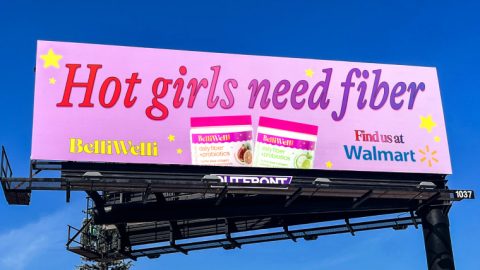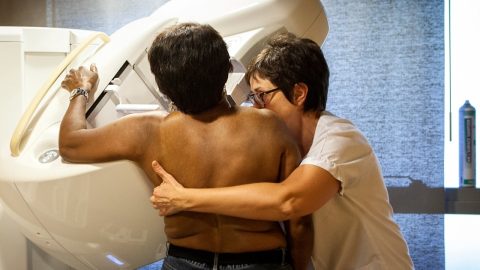Warning: This article discusses eating disorders. If you or a loved one is struggling with an eating disorder, the National Eating Disorders Association offers a free and confidential screening tool, support, resources and treatment options.
As an anti-diet culture influencer in recovery from an eating disorder, she says, Phaith Montoya prefers not to engage with body-shaming social media posts. She tells TODAY.com she’d retired from battling people in the comments on TikTok — until last month, when so many of her 3 million followers started asking her about #SkinnyTok that she decided to take a look.
The content posted with the hashtag reminded her of the 2010s-era “pro-anorexia Tumblr” and “eating disorder Twitter,” so she decided to speak out in a TikTok that’s since gotten over a million views.
Montoya, 27, was about 9 years old when she was first put on a diet. She ate less than her brother but weighed more, and her doctor was concerned. Without any referrals to counselors or dietitians, she says her parents did the best they could.
Montoya cycled through restrictive fad diets and their emotional fallout for years, and eventually was diagnosed with hypothyroid disease, which can lead to weight gain, among other symptoms, according to Mayo Clinic. In college, she started seeing mental health and nutrition professionals who gave her science-backed tools and support. She also learned she’d been struggling with binge-eating disorder.

Now years into her recovery, Montoya says she was still “so jarred, so taken aback” by what she saw on SkinnyTok.
“I know that if I had seen that (advice) when I was younger, I would have thought I needed it, too,” she says. “I felt inclined to speak for the girl that I was.”
In her response video, Montoya explained that her mental health was at its lowest when her eating disorder peaked, and her “life completely changed when I just stopped hating myself.” She said she wanted to reject the message she observed in so many SkinnyTok videos — that thinness leads to happiness.
What is SkinnyTok?
“SkinnyTok” is hugely successful by the numbers, with thousands of posts and millions of views across several platforms, including TikTok, Instagram, Facebook, YouTube and a popular Reddit thread. A Google search estimates there are about 38,000 TikTok posts with the hashtag.
The results page for “SkinnyTok” on the platform that inspired the name shows a message that reads, “You are more than your weight,” which, if tapped on, shares links to help find support for disordered eating, including the National Eating Disorder Association (NEDA). TikTok’s health resources were developed in collaboration with experts like Cleveland Clinic, National Institute of Mental Health, World Health Organization and more, a spokesperson says.
But beneath this banner are thousands of videos displaying weight-loss advice, body checks and before-and-afters packaged with words like “discipline,” “tough love” and “hard truths.”
Creators in the SkinnyTok world, most of whom appear to be women in their teens and 20s, often reshare their favorite “SkinnyTok” sayings. Some common ones are:
“If your stomach is growling, pretend it’s applauding you.”
“To be small, eat small. To be big, eat big.”
“You don’t need a treat. You’re not a dog.”
On a given day, SkinnyTok devotees — and there are plenty — may be exposed to videos recommending calorie counts so low that I, as a registered dietitian, would almost never suggest them, not for a petite woman nor a still-growing teen. Research shows that extreme weight loss and fad diets don’t work in the long term, typically ending in regain, and the changes in metabolism and hormones may leave a person struggling more than before.
I also encountered little to no content about important nutrients like calcium, iron or vitamin D in my time searching the hashtag. Another theme noticeably missing? Joy, whether from moving your body, a tasty, nutritious meal, or achieving a non-scale victory.
According to TikTok’s community guidelines, it does “not allow showing or promoting disordered eating and dangerous weight loss behaviors.” However, content “that shows or promotes potentially harmful weight management” is allowed but restricted to people 18 or older and doesn’t appear on the For You Feed.
The TikTok algorithm also blocks repetitive content patterns, which can prevent videos about weight loss, extreme exercise and similar topics from being viewed too often, according to a spokesperson.
Is the advice on SkinnyTok that harmful?
Much of the advice on SkinnyTok boils down to eating less and moving more as the only way to lose weight, and it ignores the complexity of the science around weight loss and the relationship between health and weight. (TikTok says it works with independent fact-checkers and public health authorities to verify the accuracy of content and may apply warning labels when it cannot be verified.)
But the main concern of the experts I spoke to was that many videos were encouraging viewers to feel shame around certain habits, which can have lasting, dangerous effects, research shows.
Scrolling through SkinnyTok, “I hear, ‘You’re not good enough. You’re not trying hard enough,’” Paula Edwards-Gayfield, licensed professional counselor and NEDA board member, tells TODAY.com. “If we remove the external behaviors, what’s underlying eating disorders is this core belief that I’m not good enough.”
Feelings of shame can make weight loss and implementing healthier behaviors more difficult, research shows, whereas self-compassion makes them more likely. That’s why I often tell my clients that their bodies deserve respect right now because shame-style coaching is based on bias, not science.
Dietitian Andrea Mathis of the Beautiful Eats and Things blog recently wrote about SkinnyTok’s “dangerous rise” and how she understands why people are clamoring for content that claims to help you become the ideal body type.
“Intentional weight loss is sometimes the right thing to suggest, and I’ve seen people say (SkinnyTok) has made them more aware of what they put into their body,” Mathis tells TODAY.com.
While there’s nothing wrong with that on the surface, she worries there’s too much emphasis on restriction. “Maybe it starts one way, but the more you do it with that mindset, it can turn into obsession,” she explains.
According to NEDA, exposure to weight stigma, in particular the message that “thinner is better,” can lead to disordered eating behaviors or a diagnosable eating disorder. People who struggle with depression and anxiety have a higher risk of eating disorders, and research links social media use to these conditions.
People with eating disorders, about 9% of the U.S. population, often get trapped in a lifelong recovery process and sustain physical damage, including heart problems, gastrointestinal issues, cognitive declines, organ failure and more.
For many, the struggle turns fatal. Eating disorders, especially anorexia, are among the deadliest mental health conditions, alongside substance use disorders. People of color are especially at risk because they’re less likely to receive care, according to NEDA.
If you’re interested in losing weight, it’s best to talk to a dietitian or other health professional. The most effective approach for you will depend on your age, medical history and more, and you can’t get that specificity from an influencer online.
“Even if some of the creators have good intentions, they are sometimes giving nutrition advice, which they should not do,” Mathis says.
Liam Fisher-Layton, a fitness content creator, tries to combat shame-fueled weight loss tactics on social media, in particular for men and boys, who are also at risk of eating disorders. He prefers to highlight the benefits of protein, fiber and other nutrients, as well as fun activity, instead of restriction and punishing gym routines.
“What I see a lot of (men and boys) saying is, ‘I need the toxic motivation,’” which he finds unfortunate, he tells TODAY.com. “Maybe it helps this small percentage of people, and it doesn’t cause an eating disorder, but how many others are going to be harmed? Is the benefit worth the cost? To me, absolutely not.”
Is body-shaming back?
Mathis says seeing the SkinnyTok trend “broke my heart. I felt like we were going backwards.”
But body-shaming never really left us, according to Martha Laham, author of “Made Up“ and an expert on body image and marketing.
“SkinnyTok is just another version of something we’ve seen in the past,” she tells TODAY.com.
Citing the 1920s flapper diet, the 1960s obsession with supermodel Twiggy and 1990s “heroin chic,” Laham says, “The types of media and how we pursue it may be new, but the thin ideal has always been there when we take a historical look at Western beauty.”
Edwards-Gayfield agrees that SkinnyTok is just an extension of the already prevalent, restrictive “diet mentality.”
“It just really (embodies) the entirety of what my patients experience,” she adds. “It is so ever-present that it’s difficult for people to acknowledge that it’s dieting. It’s easy to normalize it because people don’t think there’s a problem with the behavior.”
Laham points out in her book that decades of research show clear ties between consumption of “appearance-focused media” and disordered eating and body image, especially for young women. She hopes more people can learn to see through it.
When to get help
If you’re worried you or a loved one might be at risk of an eating disorder due to social media, keep in mind the warning signs, Edwards-Gayfield says.
For example, are your thoughts increasingly consumed with diet and exercise routines? Are you withdrawing from meals with friends and family because you need to adhere to a strict regimen?
“This is where things start to go into disordered territory,” and it’s time to get help, she says. That’s especially true when a person turns to other harmful, “emotionally driven” behaviors, such as exercising when injured or substance use, she adds.
The bottom line? You may be able to learn some tips on social media that can help you meet your fitness goals, especially if you’re focused first on caring for yourself, but experts agree you can’t hate yourself healthy.
For example, I often recommend unsweetened sparkling water as a replacement for soda to reduce added sugar and foster an appreciation for less sweet tastes. What I don’t do is suggest it as a replacement for a meal.
You may also want to try curating your feed. On TikTok, it’s possible “to filter out videos with words or hashtags (you) don’t want to see from (your) For You or Following feed,” the website notes. Just go to your content preferences, and add the keyword you no longer want to engage with.
Following creators and groups who nourish your mind, body and soul can also make your feed more positive. Here are a few suggestions from the experts, as well as my own:
- Chrissy King, author of “The Body Liberation Project”
- The Nutrition Tea, Shana Minei Spence, dietitian and author of “Live Nourished”
- Phaith Montoya, eating disorder advocate and NAMI ambassador
- Beautiful Eats and Things with Andrea Mathis, dietitian
- The Plant Slant, Liam Fisher-Layton, for comments on everyday nutrition and fitness trends
- Diets Don’t Work with anorexia survivor and advocate Debbie Lesko
- Keep it Up, Cutie, with comedian and body-positive advocate Anna Przy
- Joshua McFadden, author of “Six Seasons: A New Way With Vegetables”
- Your Latina Nutritionist, Dalina Soto, dietitian and author of “The Latina Anti-Diet”
- Project Heal, a nonprofit for accessible eating disorder recovery
- Ilona Maher, Olympic rugby champion
Recovering from an eating disorder can take years, as Montoya can attest.
These days, she has a happier, healthier relationship with food and her body, but “it took a lot of help and resources to get there,” she adds. She hopes that speaking out against SkinnyTok can prevent others from needing the same.









Recent Comments